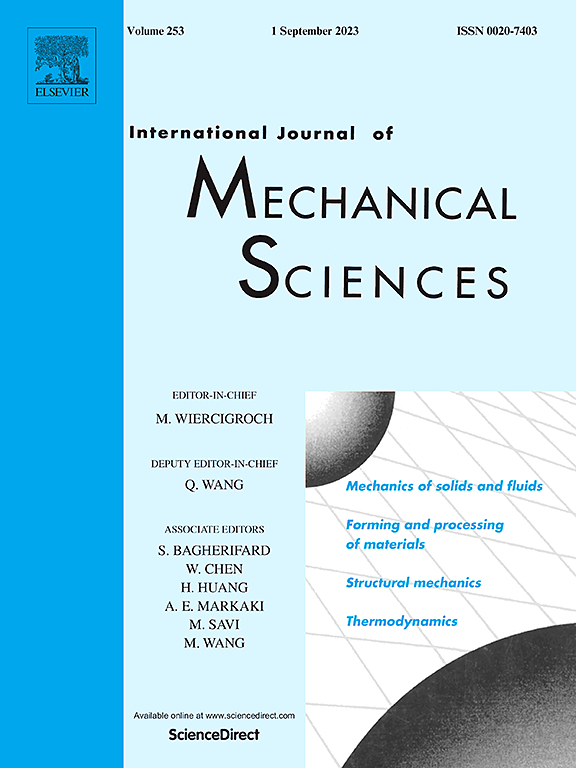Modeling of discrete-continuous contact behaviors in multilevel helical structures
IF 7.1
1区 工程技术
Q1 ENGINEERING, MECHANICAL
International Journal of Mechanical Sciences
Pub Date : 2025-02-01
DOI:10.1016/j.ijmecsci.2025.109977
引用次数: 0
Abstract
Multiple contact problems within multilevel helical structures, characterized by both line (continuous) and point (discrete) contact states, have attracted significant attention. The local unique interplay of the multilevel helical structures arises from the periodic contact between entwined helices. The quantitative characterization of internal contact behavior has always been a challenging problem. Since the transposition contact characteristic is neglected, previous theoretical models are unable to directly solve local contact behaviors of multilevel helical structures. Herein, a theoretical model is developed to address discrete-continuous contact problems within multilevel helical structures under axial tension. This research primarily focuses on the explicit derivation of concise expressions for discrete and continuous contact forces. The theoretical model is established according to the general thin rod theory combining with the elastic Hertz contact formulation. The contact transmission formulation based on the action–reaction principle is introduced to capture the contact interplay between different structural levels. The normal contact stiffness (NCS) of multilevel helical structures is further calculated. Theoretical analysis and finite element (FE) simulations reveal that the transposition contact characteristic ensures that the discrete point contact force remains nearly constant along the axis of helical structures. This consistent point contact force enables the even distribution of external loads to each helix, thereby improving the load-bearing capacity. Further investigation highlights the critical role of a trade-off between dimensionless point contact force and NCS in determining the mechanical performance in multilevel helical structures. The effective prediction range of the present model covers geometric parameters of engineering sub-cables. The theoretical model effectively extends the classical Costello model to address complex contact problems within multilevel helical structures, providing valuable theoretical guidance for designing helical structures with superior normal contact stiffness and excellent load bearing capacity.

求助全文
约1分钟内获得全文
求助全文
来源期刊

International Journal of Mechanical Sciences
工程技术-工程:机械
CiteScore
12.80
自引率
17.80%
发文量
769
审稿时长
19 days
期刊介绍:
The International Journal of Mechanical Sciences (IJMS) serves as a global platform for the publication and dissemination of original research that contributes to a deeper scientific understanding of the fundamental disciplines within mechanical, civil, and material engineering.
The primary focus of IJMS is to showcase innovative and ground-breaking work that utilizes analytical and computational modeling techniques, such as Finite Element Method (FEM), Boundary Element Method (BEM), and mesh-free methods, among others. These modeling methods are applied to diverse fields including rigid-body mechanics (e.g., dynamics, vibration, stability), structural mechanics, metal forming, advanced materials (e.g., metals, composites, cellular, smart) behavior and applications, impact mechanics, strain localization, and other nonlinear effects (e.g., large deflections, plasticity, fracture).
Additionally, IJMS covers the realms of fluid mechanics (both external and internal flows), tribology, thermodynamics, and materials processing. These subjects collectively form the core of the journal's content.
In summary, IJMS provides a prestigious platform for researchers to present their original contributions, shedding light on analytical and computational modeling methods in various areas of mechanical engineering, as well as exploring the behavior and application of advanced materials, fluid mechanics, thermodynamics, and materials processing.
 求助内容:
求助内容: 应助结果提醒方式:
应助结果提醒方式:


